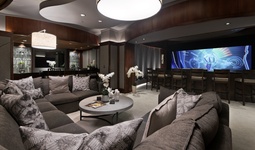
We’ve moved past the big showy sound system that sat proudly in the corner of the media room. These days, many homeowners want immersive, house-wide sound—minus the bulky equipment.
The trend toward music streaming has given rise to a new breed of audio equipment that goes largely unseen: in-wall and in-ceiling architectural speakers powered by audio components that can be stashed out of sight. Now homeowners no longer need to be within earshot of the big freestanding speakers of yesteryear. With WiFi connectivity and room-by-room sound, their music or podcasts go where they go.
A growing preference for clean, clutter-free living spaces is another reason for built-in audio systems.
“Combined with cloud-based music streaming services, customers can eliminate any evidence of equipment or wiring in their homes. This design aesthetic can be extremely appealing, so once customers see what is possible, they tend to get hooked,” says Frank DeFilippis, Builder Channel Manager with Sonos.
Architectural speakers are a desirable amenity, and thankfully you don’t need to be an audiophile to know how to install them. Here’s what to know:
Think beyond the home theater
Stunning sound shouldn’t be limited to the media room. Homeowners increasingly want quality audio throughout the house; open-concept kitchens, en suite bathrooms, home offices, and gaming rooms. The best way to prepare a living space for architectural audio is to consider the necessary wiring infrastructure early in the construction process. Placing audio cables in key locations is relatively inexpensive, but it has to be done early enough. Home technology integrators can help with prewire design and installation.
Keep speakers discreet
In-wall and in-ceiling speakers can blend seamlessly, mounted flush with grilles painted to match. There are also several third-party options, such as Fruition Designs and Wall-Smart, that provide flush-mounting solutions that are compatible with major audio brands, so you’ll find something that suits the space. The art of concealment also extends to the sound bar — even this can be hidden thanks to products like the Leon Tonecase, which masks the component behind a mesh screen.
Equip it for streaming and smart home compatibility
Nearly 80 percent of people listen to music on a streaming service. So, a whole-home sound system that doesn’t broadcast Spotify or another streaming provider does little good. Components such as the Sonos Amp make equipment streaming-compatible. Amp powers passive speakers, connects to WiFi, and offers easy control of music, audiobooks, and podcasts from your mobile device.
You’ll also want to make sure the audio system you specify is compatible with other smart-home tech you may be incorporating. The Sonos Smart Home Ecosystem integrates with major home software solutions such as Alarm.com, NICE, Crestron, and Control4.
Leave it to the professionals
If you need help, turn to the pros at the Home Technology Association. This ever-growing community of specialists works closely with builders, designers, architects, and homeowners to outfit homes with cutting-edge audio and smart-home technology.
Find an HTA Certified integrator here: https://htacertified.org/app/company_directory/


 Offers CEU Credits
Offers CEU Credits












